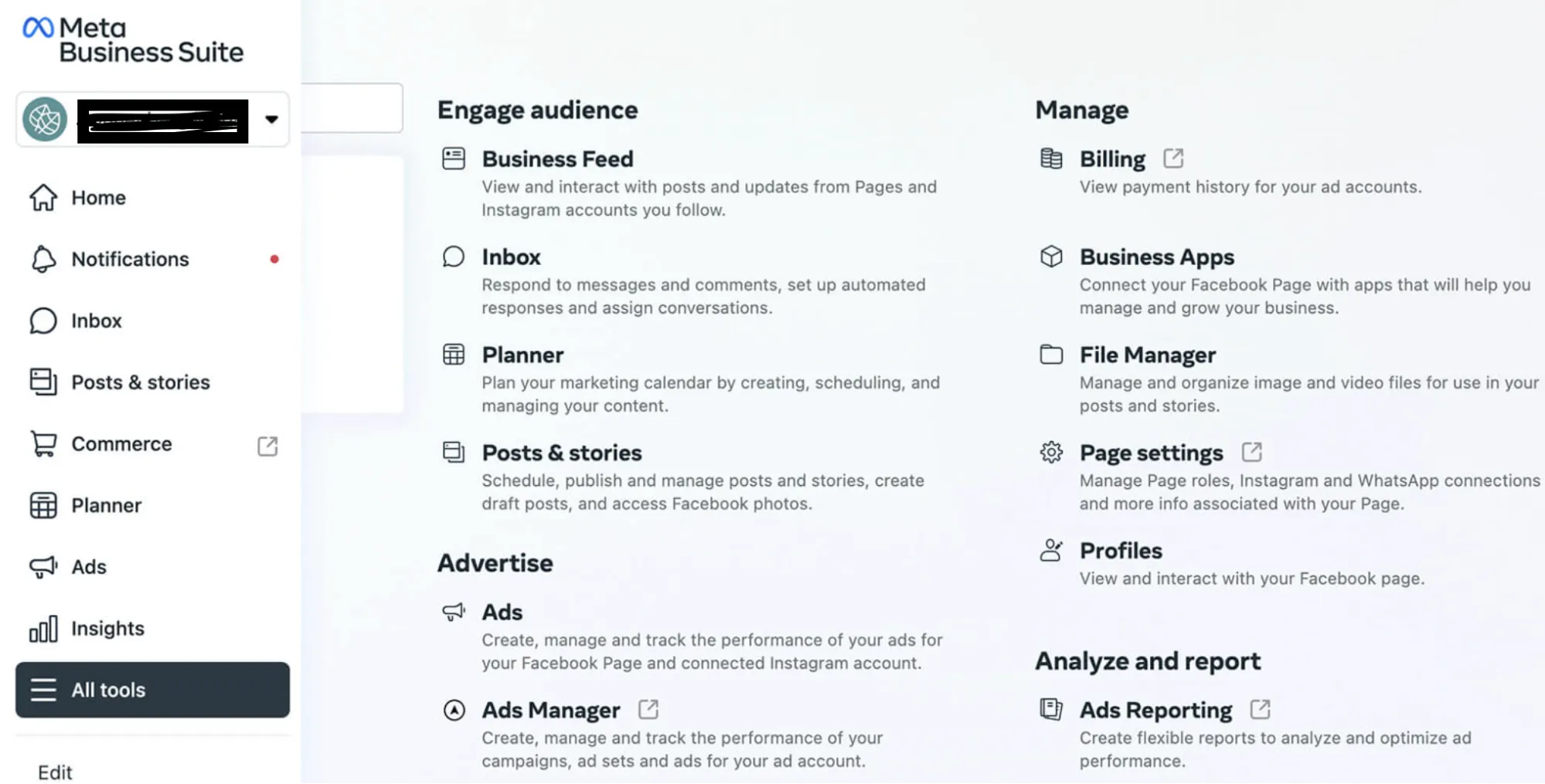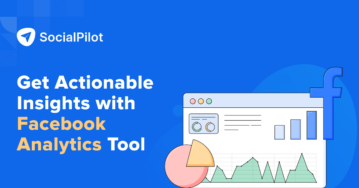Facebook Analytics was more than just a tool; it was the compass guiding businesses through the heartbeat of their audience’s interactions on the platform. With an estimated 4.9 billion people actively using social media in 2024, understanding audience behavior on platforms like Facebook is paramount.
A testament to its significance?
As per statistics, 73% of B2C and 62% of B2B marketers are keen on diving deeper into Facebook insights.
While the original Facebook Analytics may have sunset, the quest for understanding audience interactions on the platform is far from over. New tools and avenues have emerged, offering fresh perspectives and insights.
As businesses adapt and evolve in this dynamic social media ecosystem, the journey to mastery continues. Whether you’re a seasoned marketer or just setting sail, this article is your guide. Let’s embark on this journey together, navigating the ever-evolving landscape of Facebook data analytics.
Ready to dive in?
What is Facebook Analytics?
Facebook Analytics was once the beacon for businesses and marketers on the platform. It served as a comprehensive tool that provided invaluable insights into how users interacted with content. This allowed businesses to tailor their strategies, ensuring they reached their target audience effectively and fostered engagement.
The importance of Facebook Analytics cannot be overstated.
As marketers, the data it provided was crucial. It offered a deep dive into user behavior, from the basic metrics like page views and likes to more advanced insights such as user demographics, peak activity times, and the customer journey from discovery to conversion.
How did this benefit businesses?
This data-driven approach enabled businesses to refine their content strategies, optimize ad campaigns, and ultimately achieve a higher return on investment.
However, the landscape changed when Meta (formerly Facebook) announced the discontinuation of its native Facebook Analytics tool. As of June 20, 2021, this standalone tool ceased to be available, leaving a significant gap in business analytics offerings.
The discontinuation of Facebook Analytics was pivotal. But did it mean the end of analytics for the platform?
Absolutely not!
Meta introduced new tools and shifted its focus to other analytics solutions. One such prominent tool is the Meta Business Suite, which amalgamates various functionalities, including insights for both Facebook and Instagram. This suite offers a holistic view of a brand’s presence across the two major platforms, ensuring businesses still have access to the data they need to thrive.
So, what are these tools that have replaced Facebook analytics?
Let’s find out.
Best Facebook Analytics Tools for 2024
Facebook, now transitioning to the name “Meta,” has recommended a shift in analytics efforts to three primary tools:
1. Meta Business Suite
Meta Business Suite is a key tool for businesses to analyze their Facebook and Instagram activities. It provides insights into both organic and paid engagements, aiding informed decision-making. The “Insights” tab offers a snapshot of page reach, top content, and audience details.

Users can set goals, and the platform suggests ways to achieve them. The “Results” section presents metrics like page visits and growth comparisons to past data. The suite also supports data export for deeper analysis.
How to Access Analytics in Meta Business Suite:
- Log into Facebook with your business account.
- You’ll be automatically redirected to the Meta Business Suite dashboard when accessing your business account on a desktop.
- Click on “Insights” to view a comprehensive breakdown of your metrics.
- For a focused view of Facebook metrics, navigate to “Content” and deselect Instagram options to view only Facebook data.
2. Facebook Page Insights
Facebook Page Insights is an important tool for understanding your Page’s performance. This analytics platform provides detailed insights into your audience’s interactions, helping you fine-tune your content and engagement strategies.
What does it offer?
Page Insights gives you access to real-time and historical data about your page’s reach, engagement, and audience demographics. You can track essential metrics like page views, likes, reach, post engagement, and more. This tool allows you to see how your content is performing, who your audience is, and how they interact with your page.
These insights are crucial for businesses to identify the types of content that resonate most with their audience, optimize their posting times, and understand overall page health.
How to Access Analytics in Facebook Page Insights:
- Log into your Facebook Business account.
- Go to your Page.
- Click on ‘Insights’ at the top of the Page.
- Here, you’ll find detailed metrics on various aspects of your Page’s performance.
Facebook Page Insights helps you make informed decisions about your content and engagement strategy on the platform, ensuring that you connect effectively with your audience.
3. SocialPilot’s Facebook Analytics
So, why SocialPilot’s Facebook analytics?
SocialPilot emerges as a robust platform dedicated to offering actionable insights specifically for Facebook. Unlike native tools, SocialPilot’s Facebook Analytics is designed to give businesses a more in-depth understanding of their audience’s behavior and engagement patterns.
The platform provides a comprehensive overview of your Facebook account’s state, highlighting key metrics such as fan growth, post engagement, and overall reach. The tool allows users to compare current data with previous periods, offering a perspective on progress and trends.
One of the standout features is the ability to monitor audience growth trends, distinguishing between organic growth and results from paid campaigns. This differentiation is crucial for businesses to understand the effectiveness of their marketing strategies.
Furthermore, SocialPilot’s detailed analytics reports provide a comparative view of a Facebook account’s performance against other platforms.
This holistic approach ensures businesses can pinpoint their strengths and areas of improvement, making SocialPilot’s Facebook Analytics an invaluable asset for any marketer aiming for success on the platform.
What do SocialPilot’s Facebook Analytics have to offer?
SocialPilot: New and Improved Facebook Analytics Dashboard
- Comprehensive Overview: Gain a complete view of your Facebook account observing metrics like fan count, post frequency, total engagement, and more.
- Audience Insight Monitoring: Track the growth of your Facebook audience, distinguishing between organic growth and acquisitions from paid campaigns.
- Detailed Analytics: Access a breakdown of audience engagement for your pages and individual posts, helping you understand what resonates with your audience.
- Share-Ready Reports: Generate detailed analytics reports, compare your Facebook performance against other channels, and easily share these insights in a downloadable PDF format.
How to Access Analytics for Facebook on SocialPilot:
- Log into SocialPilot: Start by logging into your SocialPilot account.
- Navigate to Facebook Analytics: Once logged in, inspect every connected Facebook Page. SocialPilot provides in-depth reports accessible from a single dashboard.
- View Comprehensive Reports: Generate PDFs of these reports, download, email, or schedule them to send to others with just a few clicks. You can even customize these reports by adding your logo and name before sharing them with clients.
- Select Date Range: Choose to view data for the last 7 Days, 15 Days, 1 Month, 3 Months, or any date range within the last 90 days. For Facebook, you can select a custom date range to view reports.
- Dive into Specific Sections: Analytics for Facebook pages on SocialPilot is divided into two main sections: Page and Post.
- Page Section: This provides insights into your page’s overall performance, including follower growth, impressions, engagement, active fans, and more.
- Post Section: Here, you can see details about the type of content you’ve posted and how they perform in terms of reach, engagement, shares, etc. For video content, you can also view the total watch time.
- Explore Metrics in Detail: Each section has various metrics. For instance, under Page Analytics, you can view metrics like Total Page Likes, Page Reach, Page Engagement, and more. Under Post Analytics, you can see metrics like Posts Published, Post Reactions, Post Reach, and Post Engagement.
Important Facebook Analytics Metrics to Follow
Facebook Analytics is more than just numbers and graphs; it’s the story of your audience’s journey on your platform. By understanding these metrics, businesses can make informed decisions, refine their strategies, and engage better with their audience.
Let’s delve into some of the most crucial metrics that every marketer should be tracking:
1. Reach: Ever wondered how many people actually see your content? That’s what reach is all about.
- Organic Reach: This is when your post naturally pops up on someone’s feed. It’s like a friend recommending a good book.
- Paid Reach: This is when you’ve put some advertising dollars behind your post. It’s more like a billboard on a busy street.
2. Engagement: This is the digital equivalent of a round of applause.
- Likes: A simple nod of approval.
- Comments: When someone takes the time to write a comment, it’s like a conversation at a café.
- Shares: This is when your content truly resonates, prompting someone to share it with their friends.
- Clicks: A sign of genuine interest, like someone walking into a store after seeing a display window.
3. Impressions: Think of this as echoes. It’s about how many times your content reverberates across Facebook, appearing multiple times on feeds.
4. Click-Through Rate (CTR): Imagine telling a story. CTR tells you how many were intrigued enough to ask for more details.
5. Cost-Per-Click (CPC): Every marketing effort has a cost. CPC breaks down what each interaction costs you, helping you gauge if it’s money well spent.
6. Relevance Score: Ever taken a quiz? This is Facebook’s way of grading your ad’s fit with the audience. The better the fit, the higher the score.
7. Audience Demographics: It’s like a backstage pass to your audience’s world.
- Age & Gender: Helps you understand who’s most engaged.
- Location: Offers insights into where your fans are.
- Interests: A sneak peek into what else they like.
8. Ad Spend: Keeping tabs on your budget? This metric tells you how much you’re investing in reaching out.
9. Video Metrics: Videos are like mini-movies. But are they blockbuster hits?
- Video Reach: How many tuned in?
- Average Watch Time: Did they stay for the full show or just the trailer?
10. Page Interactions: It’s about understanding what people do once they’re on your page.
- Actions on Page: Are they browsing, shopping, or just looking around?
11. Event Tracking: This is about the journey after the click. Did they explore, purchase, or sign up?
12. Page Views: This metric counts the number of times any page of your Facebook business profile has been viewed by someone.
13. Post Reach vs. Post Engagement: While ‘reach’ tells you how many people saw your post, ‘engagement’ dives deeper into how many interacted with it. Comparing the two can offer insights into content effectiveness.
14. Frequency: This tells you how often a person saw your ad on average. It’s useful to ensure you’re not overexposing your audience to the same ad.
15. Negative Feedback: Not all interactions are positive. This metric tracks actions like hiding your post, unfollowing your page, or marking it as spam.
16. Conversion Rate: For businesses with specific call-to-actions, like signing up or making a purchase, this metric calculates the percentage of users who take the desired action after clicking on your content.
17. Return Visitors: It’s always good to see familiar faces. This metric tracks users who’ve visited your page more than once, indicating sustained interest.
Diving into these metrics is like piecing together a puzzle. Each piece, each number, adds to the bigger picture, helping you understand, adapt, and thrive in the Facebook universe.
4 Reasons to Track Facebook Analytics
Facebook Analytics is more than just a dashboard of numbers and graphs; it’s a treasure of insights that can transform how businesses approach their digital strategy. Here are four reasons why it’s indispensable:
1. Strategic Decision Making
As we mentioned, Facebook analytics isn’t just about numbers; it’s about understanding the narrative behind those numbers. Analyzing these metrics allows businesses to discern their audience’s patterns, preferences, and behaviors.
For instance, if there’s a surge in engagement every time a video post is shared, it clearly indicates the content type that resonates with the audience. This insight can be pivotal in shaping future content strategies, ensuring that every post and every campaign is tailored to the audience’s liking. It’s like having a roadmap that guides businesses in making strategic and effective decisions.
2. Optimized Advertising Budget
Ensuring every dollar spent yields the maximum return is crucial in digital marketing. Facebook analytics provides granular data on ad performance, from reach and impressions to clicks and conversions. By studying these metrics, businesses can identify high-performing ads and allocate more budget while re-evaluating or tweaking underperforming ones.
It’s not just about spending money; it’s about spending it wisely. And with Facebook Analytics, businesses have a tool that ensures they get the best bang for their buck.
Example: Golden Goose
Golden Goose, a renowned brand, utilized Facebook’s advertising platform to enhance their brand awareness. They embarked on a multi-phase campaign using Facebook video ads.

The primary objective was to reach a broader audience and create a lasting impression, ensuring that their brand remained top-of-mind for potential customers.
By leveraging Facebook Analytics, Golden Goose could monitor their real-time video ads’ performance. They could see metrics like video reach, average watch time, and engagement rates. This data was invaluable. If a particular video ad wasn’t performing as expected, they could quickly adjust their strategy by tweaking the ad creative or refining their audience targeting.
The results?
A significant boost in brand awareness and recommendations. Golden Goose ensured that every dollar spent was effectively contributing to their campaign goals by optimizing their advertising budget based on real-time data from different Facebook analytics.
3. Holistic Understanding of the User Journey
Facebook Analytics provides a comprehensive view of the user journey, from the initial interaction on the platform to the final conversion.
This includes tracking actions taken in the News Feed and understanding their impact on company websites, apps, and even physical stores. For instance, businesses can trace a user’s path from liking a post, clicking on a link, visiting a website, and eventually making a purchase.
What does this mean?
Such a detailed view allows businesses to identify potential bottlenecks in the conversion process and optimize the user experience accordingly.
4. Better Understanding of Demographics
Gaining a comprehensive understanding of your audience’s demographics is key for businesses striving for success on platforms like Facebook.
This insight doesn’t just offer a snapshot of your audience but paints a detailed picture of their preferences, locations, and engagement patterns. Such knowledge is instrumental in tailoring content that resonates more profoundly with the audience, leading to heightened engagement rates.
Moreover, it empowers businesses to target their ads precisely, ensuring the right message reaches the right audience segment, optimizing conversion rates.
What more?
This demographic clarity aids businesses in making informed decisions about resource allocation, focusing on audience segments that promise the best return on investment. For those in the product or service sectors, these insights can be pivotal in refining product development and marketing strategies based on audience preferences.
Conclusion
Navigating user interactions on platforms like Facebook is more crucial than ever. With the evolution from Facebook Analytics to Meta’s innovative tools, businesses are equipped with powerful instruments to decipher audience behavior.
Tools like the Meta Business Suite, Facebook Ads Manager, and Events Manager, complemented by third-party solutions such as SocialPilot, offer a wealth of insights.
As 2024 unfolds, leveraging these analytics tools will be essential for businesses aiming for impactful digital engagement and success on Facebook and its associated platforms.




